Red Herring, USA
Situated in a new mixed-use development on a bustling street in Downtown Los Angeles, Red Herring restaurant and bar is timeless, energised, and bathed in a California attitude. Downtown Los Angeles is rich with history, which heavily inspired the new scheme for Red Herring; using a splendor of colour, Art Deco geometry, soft curves, and splashes of flora and fauna whimsy along with a custom focal point mural by Mike Willcox, this space has quickly become a design destination.
Building on an already well established working relationship, designer Marissa Zajack was brought on board the project by restaurant owners David Woodall and Alexis Martin-Woodall. David is a prominent chef in LA and Alexis is the President of Ryan Murphy Television, and both have admired the design style of Zajack and worked with her in the past on branding projects.
“The design project was a complete build-out and took a full year,” explains Zajack. “I wanted the restaurant to feel as though it was grounded in the environment around us. Downtown LA is filled with historical buildings that came to life in the early 1900s; Red Herring is Art Deco meets California cool. There are many textures and geometry mixed with a large fauna and flora mural, and soft curves and arches. There is also custom lighting throughout that plays off the architecture and design elements.”

Working on a restricted budget, Zajack explains that the main challenge of this particular design was making the most of the money she had to work with. “It made me think more inventively and look to sources and artists that were lesser known to achieve an individual and bold statement,” she says. “I really loved the idea of using up-and-coming innovative artists. For the most part, it all worked out, but of course there were challenges and headaches.”
For example: “The three globe pendants in the dining room, although lovely, were a bit of an undertaking when it came to getting light sources in and out. If I had to do it again, I probably would have gone with a more experienced designer. This is where working with emerging designers can sometimes get tricky. I spent many hours getting these ready for service,” says Zajack.
Describing the lighting working as another “detail and sculptural element within the space,” Zajack wanted to incorporate custom lighting aspects into the scheme, for example the lighting sculpture hung above the bar. “I’m a fan of Light Cookie’s Dora Koukidou and had an idea for a light sculpture. I thought she would be the perfect designer to bring the idea to life; she did and more. It is a mixed metal sculpture with illuminated globes – it’s simply stunning and works so well within the aesthetic,” explains Zajack.
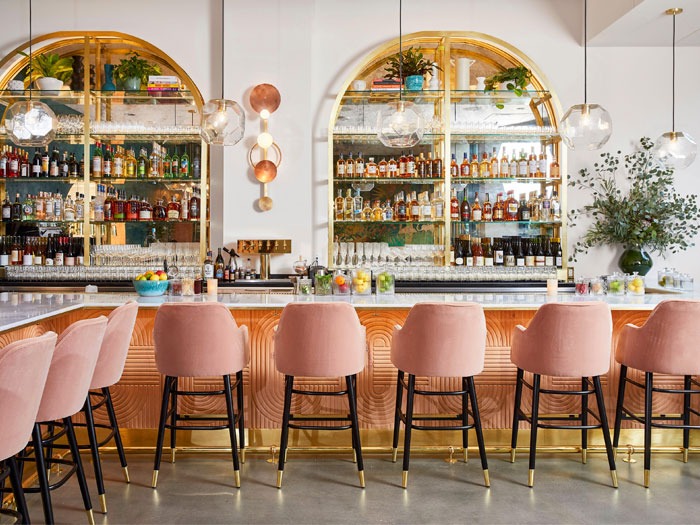
Using decorative lighting as an “extension of the story” Zajack used multiple decorative brands to complete her look for the restaurant including three globe pendants by Adir Yakobi and Mid-Century multi-light chandeliers by France and Son in the dining room; pendants from CB2 and the light sculpture from Light Cookie in the bar; and the I Do sconce by Light Cookie in the restroom. Architectural lighting was used in recessed areas and served a purpose for these spaces that the decorative lighting could not.
Looking back on the Red Herring restaurant, Zajack was very pleased with the impact the decorative lighting had on the space and its use in creating an overall atmosphere.
“The standout feature was how much of a statement the lighting in the space makes,” says Zajack. “Honestly, that’s a lot of what people talk about in terms of design. It’s such a big part of the design story and really brings everything together. It adds shine in all the right places and it’s a detail that brings everything to life and sets the mood.”
Kristof Pycke
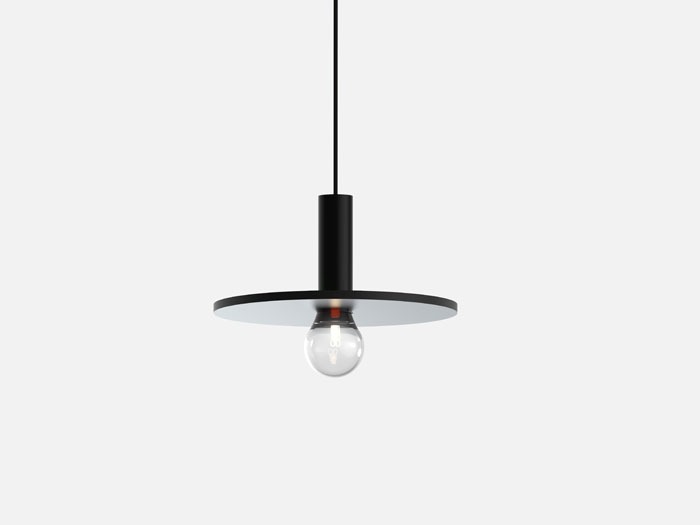
Can you tell us a bit about oran, kreon's new decorative fixture?
The new oran is a first for kreon. The lighting manufacturer is known for its sleek designs and geometrical projects. This time, though, the designers chose to switch gears. Without losing sight of their basic principles of ‘Unity in design, simplicity in techniques, and precision in detail’, kreon launches its first ornamental line.
The ornamental kreon oran line consists of pendant and ceiling luminaires. The luminaires are available in black and white, or in pure materials such as bronze. The mouth-blown bulbs come in two shapes, round or cone-shaped, or in alabaster. The pendant is optionally covered by a lampshade.
Where did the inspiration for oran come from?
kreon oran’s design is based on the architectural principle of the ‘plastic number’. The basic shapes that can be derived from the number’s proportions make up the building blocks of this new line of lighting luminaries. Designing from the plastic number, means working with spatial components. Creating spatial luminaires is in strong contrast with kreon’s earlier designing principles, which were exclusively applied in flat surfaces. In other words, oran is a first for kreon, since it is its first design to claim space, and to actively demand to be a part of it. oran’s spatiality can be seen in its proportions, as well as its dimensions and materialisation.
kreon’s team of designers was not only inspired by human concepts. Nature too was a great source of inspiration for this first ornamental line. With its geometrical patterns, the skeleton of the Venus’ flower basket goes hand in hand with kreon’s designing process. Venus’ flower basket is a sponge, which can be found in the waters surrounding Japan. The animals, which can measure up to 100cm, are structured in a vase-like shape. The way in which the sponge is woven, grants the Venus’ flower basket a sturdiness that enables the animal to survive in the ocean. kreon’s designers analysed the shape of the sponge, to transform it into the unique form of oran’s reflector inside the bulb.
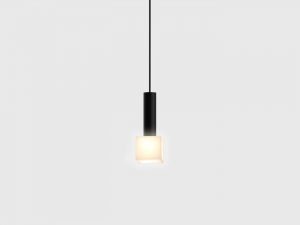
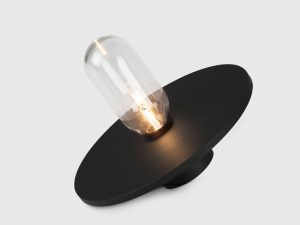
What materials and technologies have been used?
The reflector is printed with 3D techniques. To mimic the natural shape of the Venus’ flower basket, a simple element is enlarged in a tiered manner. oran’s reflector thus seems to have grown in an organic way. While using the newest techniques, kreon does not lose sight of the past: oran’s glass bulb is mouth-blown, reminiscent of the traditional trade. The oran line creates space for artisan techniques and modern technologies in one design, that effortlessly finds a compromise between future and past.
Spanish Design Report
Interiors from Spain is an initiative of ICEX Spain Trade and Investment, The Spanish foreign trade body aimed at promoting design from Spain, including lighting and furniture to the international architectural and design community. The platform offers interior designers a showcase of the latest ideas, trends and product launches coming from the country.
darc got the chance to speak with Pablo Conde Diez del Corral, Director of Fashion, Habitat and Cultural Industries at ICEX and of Interiors from Spain, to discuss how the evolution of interior design has looked in Spain.
“Many design studios have adopted a multidisciplinary approach to encompass all aspects of design including ephemeral spaces, branding, interior and product design,” he says. “The new generation of Spanish interior designers are as likely to be as interested in graphics, industrial design or even event organising as they are in interior design. Another feature that characterises the Spanish design industry are the close ties between design and manufacturing. Spain has a rich manufacturing tradition that includes furniture, lighting and textiles, and there is real interest both from interior designers and clients on products with authentic provenance that have their roots in the artisanal tradition of our industry.”
When looking at the relationship between light within interior design, Conde claims that it is a “fundamental element in any interior design project in Spain”.
“A key characteristic of lighting design in Spain is connected to the weather,” he goes on to explain. “The sunnier climate in Spain, with more daylight hours than any other country in Europe, means that designing with natural light is commonplace. Designers often need to incorporate daylight into their designs, taking into account energy and climate factors.
“There is a strong tradition of industrial development and traditional craft workshops, with materials such as metal and wood, in certain areas of the country, which means that there is a plethora of lighting manufacturers capable of supplying luminaries in all sorts of styles: from the traditional brass chandeliers to understated, sleek designs in metal, wood and recyclable materials,” he says.
Looking at trends appearing in the country at the moment, it appears Spain continues to be on par with global attitudes towards design, with Conde explaining that sustainability is at the heart of current influences.
“In recent years, the Spanish interior design industry has been increasingly working towards sustainability with more and more clients demanding eco-friendly materials and low-energy solutions.
“Also, due to the recent Covid-19 crisis, some of Spain’s most international interior designers are looking at the possibilities of incorporating cross-sectional design, that integrates versatility with health and wellbeing. In the lighting industry, this means luminaires that provide good, restful lighting, which are as functional as they are beautiful and well-proportioned.”
For the purpose of this article, Conde caught up with some Spanish interior designers to get a flavour of how the design industry is reacting to current changes. Ramón Esteve, of Ramón Esteve Éstudio, explains that space versatility is key: “Home design is going to have to respond to the needs for privacy and intimacy, taking into account all its inhabitants, especially with regard to teleworking, and terraces and balconies are going to be revalued.”
Designer Héctor Ruiz Velázquez stresses that, “on top of functional and aesthetic aspects, special attention should be paid to ergonomics implemented in our homes”.
Francesc Rifé explains that this crisis “encourages us to rethink the relationship between society and space. From now on, we believe that we will need to design interiors giving them a much more functional, optimal and healthy approach”.
Conde adds: “His studio has always designed around spatial order, but he thinks it will be crucial to reinforce this aspect to improve personal relationships; “Get the mess in order”.”
Héctor Ruiz Velázquez told Conde that “regulating the spaces we share after a health episode of such dimensions will require a multidisciplinary consensus by many experts from different areas, obviously, including essential health professionals as well.”
Conde adds: “Equipo Creativo told me that the design industry will emerge strengthened from the current situation since it provides products and services that can make people comfortable, protected and delighted. They hope that post-Covid-19, design will generate healthier socialising habits, “confinement has encouraged the idea that our homes can house disparate uses such as high-end restaurants, offices, nightclubs, or gyms. It is not unreasonable to think that home interior design should incorporate something of the design of such places, allowing inhabitants to transform their spaces according to how they want to use them. A very attractive challenge”.”
[d]arc room livestream catch up launched

(Global) – All presentations now available to watch on event platform.
Following the success of [d]arc room livestream, which attracted more than 1,000 attendees, a catch up service has been launched to give attendees exclusive access to view sessions at any time.
[d]arc room livestream took place on 16-18 September, and featured 47 presentations across two streams, broadcast to a global audience, from leading lighting industry professionals, covering the hottest topics in architectural and decorative lighting.
Speakers that participated in the event included: Durham Marenghi; Aleksandra Stratimirovic; Filippo Lodi (UNStudio); Keith Bradshaw (Speirs + Major); Kaoru Mende (LPA); Gabriele Chiave (Marcel Wanders Studio); Paul Bishop (Bishop Design); Rikus De Kock (Illuminate Lighting Design); Aticha Padungruengkit (SEAM Design); Monica Luz Lobo (LDStudio); Carla Wilkins (Lichtvision); Dan Lister (Arup); Barbara Horton (HLB); Edward Bartholemew (Bartholemew Lighting Design); Claudia Paz; Victor Palacio (Ideas en Luz); Sophya Acosta; Sakina Dugawaller-Moeller (Light.Func); Yah Li Toh (Light Collab); Dr. Kit Cuttle; Regina Santos (Godwin Austen Johnson); Nathalie Rozot (Phoscope); Brett Andersen (Focus Lighting); Francesca Bastianini (Sighte Studio); Katia Kolovea (Archifos); Richard Taylor (Graphic Strategy); Ruth Kelly Waskett (Hoare Lea); Annukka Larsen (WSP Finland); Lisa Marchesi (mldlab); Akari-Lisa Ishii (I.C.O.N.); Martina Frattura (White Pure); and Ta-Wei Lin (CMA), among many others.
Those that missed the event but want to watch all the conference talks in full can still purchase a ticket to get instant access to the event platform.
Tickets to view the conference are £10.00, and attendees will get exclusive access to the entire programme across all three days, including a technology workshop hosted by RCL and LensVector, which was limited to 50 participants during the event.
Paul James, Managing Director of [d]arc media, commented: “I am delighted that more than 1,000 people enjoyed [d]arc room livestream, which was a huge success. The catch up service will ensure that attendees can watch any sessions that they missed at any time, and will enable new attendees to register to view the exclusive content.”
Tickets are available to purchase on the [d]arc room website here.
MD Apartment, India
Acting Editor Sarah Cullen sits down with Architect Malay Doshi to discuss the renovation of his own private residence with decorative lighting features from Flos and Crystal Palace.
Along with designers Arihant Bajaj and Tejashree Karande, Malay Doshi, partner at Saransh Architects, based in Ahmedabad, India, has transformed his two-bed apartment into a designer’s fantasy studio living space.
Stripping the space back to its bare minimum, including the removal of partition walls, bathroom facilities, the kitchen and flooring, there was a conscious decision of creating a space that was minimal and at the same time tactile. As such, a majority of the materials chosen were done so based on how well they age.
Upon entering the apartment, the floorplan is completely exposed, with the only door closing off the bathroom, which is even styled with fluted glass to allow maximum light flow throughout.
Using colours and textures, the team demarcated the space’s use, using grey tones in the kitchen and toilet and wood tones were used in the den to create a more intimate atmosphere. “The kitchen and the toilet undertake only grey tones, hence creating ‘niche-like’ spaces inside the lighter white and grey general areas. The den is made of wood to give a cosy vibe, and the volume of this space is reduced drastically to give a sense of entering a different realm, which is further exaggerated by the need to climb a couple of steps to enter it,” says Doshi. “Finally, the sleeping area, is made much warmer with beige walls and a more playful floor in tones of blue. This gives it a very different aesthetic inside the house, giving it a personal touch.”
When considering the lighting for the apartment, Doshi worked with architect Mansi Mistry to obtain her expertise on customised prototypes, product selection and placement. He also took this renovation as an opportunity to play with various customisations of decorative lighting.
“Considering the tones and use of the space, the light was designed accordingly,” he explains. “For example, the two brass lights in the wooden backdrop were kept at two heights with one almost at floor level, to address the floor seating on one side of them. The frosted glass globes were chosen to create an ambient glow in the space. Similarly for the bedroom, the two spheres: one stone and one light on the yellow lime backdrop were chosen for a similar ambient glow. Whereas the extra recessed kitchen counter lights inside the metal cylinders, were done so consciously to create three separate spots of light on the wooden plank.”

Referencing these custom designed fixtures by Ahmedabad-based decorative lighting producer Cyrstal Palace, Doshi also featured Flos pendants in the living space. “One [Flos string light] is in the corner, which is a sphere to create an ambient glow and the other, a cone, is above the dining table to give a down light. These were also chosen because they could be customised with their assembly and create this juxtaposition of black lines on a white backdrop of the ceiling,” says Doshi.
Referencing the use of both architectural and decorative lighting in his home, Doshi adds: “Both of them work to create two separate moods in the space. The decorative lights create an overall ambient lighting across all spaces in the apartment, which are usually the only lights that I turn on everyday. The architectural lights create a brighter lit space, which are used only when there are guests.”


Moving into the bedroom, Doshi explains the difficulties of installing the customised Crystal Palace globe pendants: “There was a stubbornness in picking solid stone globes in the bedroom above ceramic or metal, for the want of a certain texture to their surface. This led to that specific light becoming quite heavy, which then further led to the need of a structural rope wire anchored to the RCC slab to hang it,” he explains.
The importance of juxtaposing textures is a theme that runs throughout the space. As Doshi explains further, the “entire flooring is polished concrete with different inlays, like wood, stone, cement tiles and brass. The polished concrete is filleted onto the wall up to the sill level, to give a sense of being inside concrete rather than being on it. Different greys explored, to go along with the concrete, include a grey polished marble and three types of grey fabrics used in the soft furnishings.
“The only coloured accents used in the project in shades of indigo and turquoise, are in the ceramics, cushions or shear curtains. All the walls have a pigmented lime plaster finish, which not only keeps the house cool in the hot weather of Ahmedabad, but also gives a timelessness to the space.
“The wood used is reclaimed 60-80 year old Valsad Teak from the ‘Pols’ of Ahmedabad. Not only is it more sustainable, the aged wood has an inherent rich texture.”
He added: “Leading away from the generic chic finished urban homes, a conscious choice was made to keep the ‘end product’ unfinished; to make the house an oasis in the middle of the city, similar to the natural ever-changing sense of space of a vernacular cottage.”
Reflecting on the final outcome of the renovation that took six months to complete, Doshi concluded: “Being a very personal project, the freedom to go into a previously unachieved customisation to achieve the initial idea was a standout feature here. Although the same effect could have been achieved through simpler solutions and minor compromises, the impact left by achieving exactly what was intended left me with a certain level of satisfaction which wasn’t felt before.”
Morandi - Hand & Eye Studio
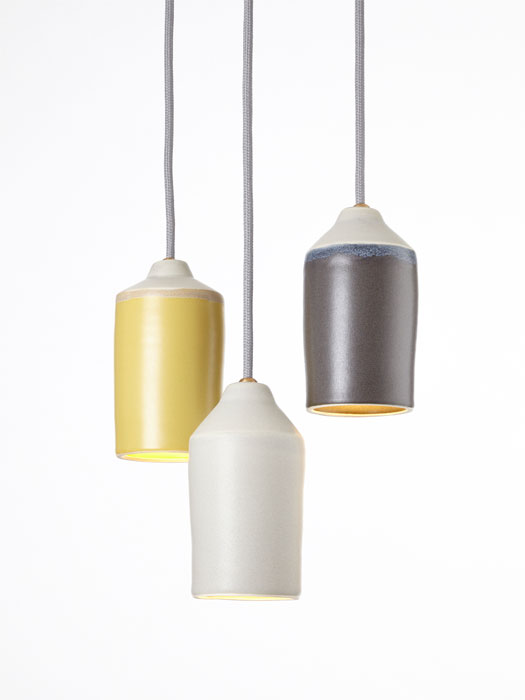
Designed and produced in collaboration with ceramicist and expert glazer Linda Bloomfield, the handmade Morandi pendants are inspired in shape and colour by the bottles shown in paintings by the artist Giorgio Morandi. Made from wheel thrown porcelain, they are glazed in two-tone with a wonderfully tactile matt-satin glaze, giving a beautiful additional effect where the two glazes overlap. Available in two shapes: narrow and wide, these small pendants look great in a cluster or row over a table, bar or island unit or even over a sideboard, side table or armchair.
There are three tonally subtle colour options to choose from: a soft yellow, dark grey with a touch of purple and light grey. The interior of each is glazed in the same colour with the rim left as the natural porcelain, to express the materiality of the clay.
Being handmade, these pendants vary in their exact size, with the rounded brass fitting peeking out of the ceramic at the top. Each one comes with a flex in a light grey textile and has a matt white metal ceiling rose with brass side screws to compliment the fitting.
Lamp Bio-s - Bonaldo
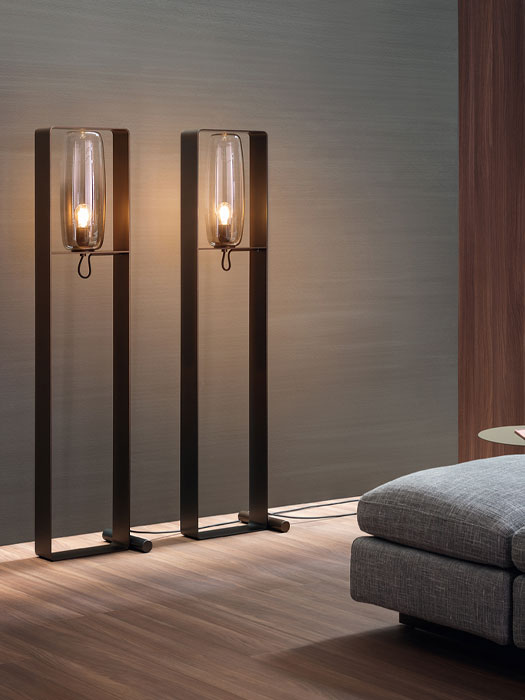
The Bio-s floor lamp is a metallic architectural structure that encloses the blown glass of the lampshade in all its elegance: contrasting elements put together in the Bio-s collection of lamps, in an expression of three-dimensionality and perspective. The design of this floor lamp does not go unnoticed, strengthened by its suggestive capacity accentuated by the lampshade, especially in the mirrored version able to reflect the environment in which the lamp is placed. Contrasts, games of reflections and a strong sculptural presence characterise the new Bio-s lamp.
Light+Light - Instabilelab
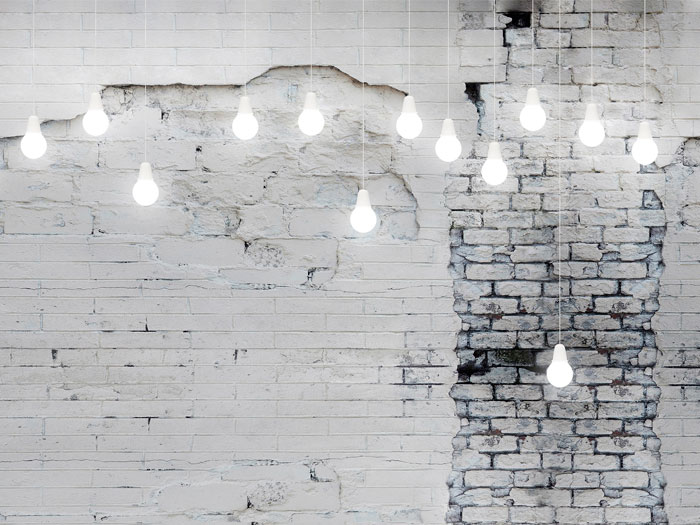
Light+Light is a collection of bright wallpapers that feature spots of illumination within its design.
The luminescent effect is obtained through the application of a phosphorescent pigments-based paint (applied by hand); the painted part absorbs any natural or artificial source of light, lighting up in the darkness for a variable time duration, depending on the exposure time.
Light+Light is printed on the Vinyl Wallpaper backings and comes in yellow phosphorescence.
Sleep & Eat and Decorex virtual event 2020
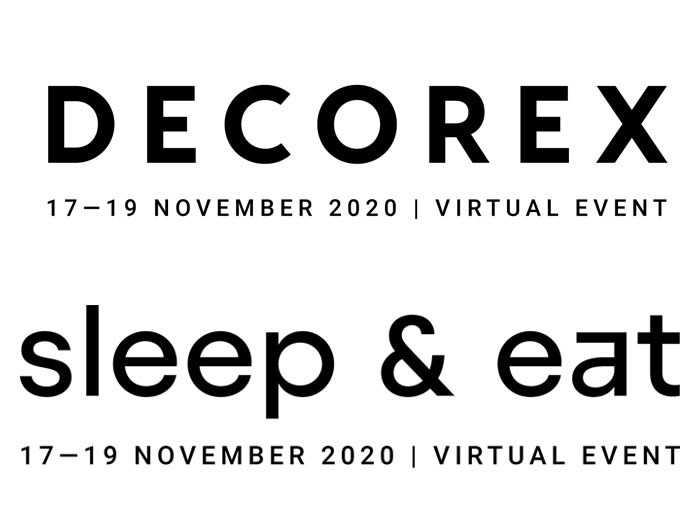
(Global) - Design events Sleep & Eat and Decorex will go virtual this November for the first time in their history.
For 15 years Sleep & Eat has been the place where the hospitality design community connects. This year’s event will deliver a unique virtual experience bringing the industry together for meetings, networking, knowledge-sharing and inspiration, from across the globe.
3daysofdesign Copenhagen launches
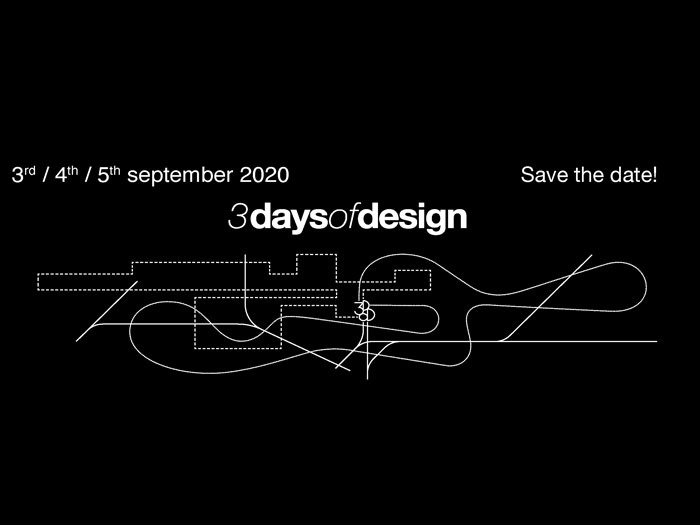
(Denmark) - 3daysofdesign invites visitors to participate in events, product launches, exhibitions, and lectures on design between 3 and 5 of September 2020.
3daysofdesign grants access to attendees to almost 200 showrooms and exhibitions located around Copenhagen in person.
This years’ edition of 3daysofdesign focuses on sustainability and the circular economy. Visitors will be introduced to new ideas that challenge the way we produce and live with design today. Pakhus 11 in Østerbro will host design talks and new showrooms will be open in Kuglegården at Christianshavn. Choose to explore more than 30 Danish and Scandinavian design brands at the design house FREDERIKSGADE 1, right next to the Marble Church. An exhibition ‘Material Matters’ is open at the Den Frie Udstillingsbygning at Østerport, and the Nordhavn area has previews of behind the scenes at brands such as GUBI and Kvadrat.
“At 3daysofdesign, we are passionate about design and the community that prevails among designers, architects, and design enthusiasts from all over the world. It is precisely in these troubled times more than ever of crucial importance to nurture our connections not only via the physical meeting but also via our digital platform - so come and visit us in Copenhagen or follow us on 3daysofdesign.dk,” says Signe Byrdal Terenziani, Managing Director of 3daysofdesign
Lighting brands that will feature at the event includes Barovier&Toso, Nuura, Le Klint, Artemide, Flos, Louis Poulsen, Occhio, Møller & Rothe, Pandul, Secto Design, Sence and Shade.
AlmaLight shortlisted for Adi-Delta awards 2020
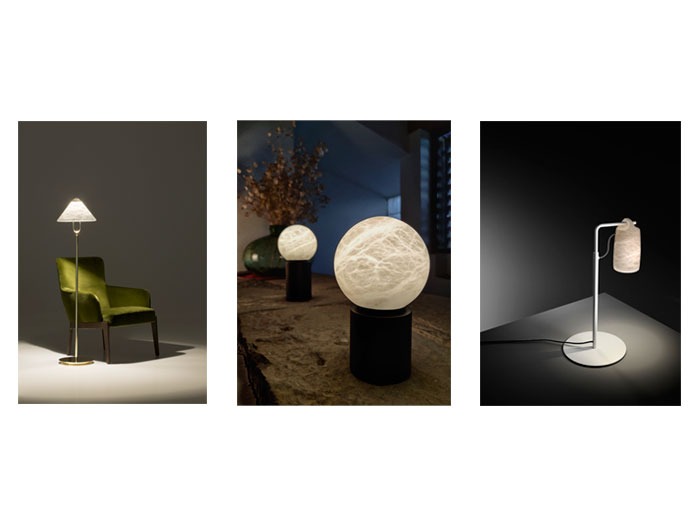 (Spain) - AlmaLight has three new products shortlisted in the Spanish Adi Delta Awards.
(Spain) - AlmaLight has three new products shortlisted in the Spanish Adi Delta Awards.
Part of its 2020 product collection, AlmaLight presents three shortlisted products for the Adi -Delta Awards.
The Delta Awards are given biennially in recognition to industrial designers and companies. Since the first edition in 1961, the Delta Awards have been an important channel for promotion and a valuable platform for public recognition for designers and companies in Spain.
The Delta Awards aim to celebrate excellence in design and emphasise its importance as a prime tool for creating wealth in an industrial economy, as well as highlighting its role as an expression of our culture. Since 2011, the Delta Awards and ADI Medals have been held during the FADfest, in 2020 they will take place in the Barcelona Design Week, which highlights the energy and wealth of Barcelona in the field of design. The finalist objects are shown to the public on the pages of the catalogue and can be viewed at the “FADexpo”.
AlmaLight's three shortlisted products include:
Tribeca USB. An extension of the Tribeca collection, with its characteristic spherical alabaster lampshade but this time turning it into a portable autonomous luminaire, which allows the touch of warmth and elegance that transmits from the alabaster stone to any corner, either indoor or outdoor, thanks to its IP45 protection. Specially designed to enhance tables and terraces of stylish restaurants.
This stone, which comes from national quarries and is very traditionally Spanish, gives each screen a unique identity, with white and grey-ish veins, sometimes with fascinating earthy hues and a smooth translucency.
They are two versions available in 20 and 24cm high that can be used individually or in groups. The structures are produced in painted galvanised metal textured in black, corten or white finishes and include a fully dimmable LED1.3W3000K150lm powered by a lithium polymer battery that is recharged using a USB cable giving the luminaire an autonomy of eight hour in full intensity.
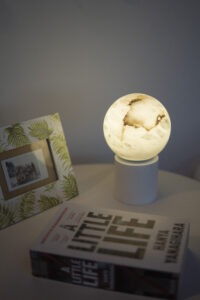
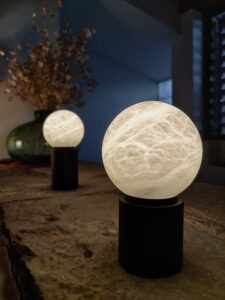
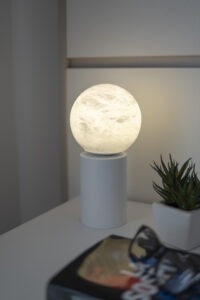
Fuji. Fuji is made with a polished brass finish, with a clearly Art-Deco influence and a conical alabaster shade inspired by the shapes of Mount Fuji, the famous Japanese volcano. Fuji transmits serenity, softness, elegance and minimalism and is a handmade collection. The alabaster denotes a great warmth and gives it a spectacular look when the light is on and off. Each shade has a unique identity and the metal structures are simple and contrast in a harmonious manner with the heaviness of the stone. The Fuji collection consists of four models: two single pendants -one with a 22cm diameter shade and the other with a 30cm diameter shade-; a table lamp with a 22cm diameter shade and a floor lamp with a 30cm diameter shade. The structures are made of iron with electrolytic bath in polished brass finish. All Fuji fixtures include a non-dimmable Seoul integrated LED of 4,6W 2700K 260lm in the case of the small shade, and four 85W 2700K 335lm in the case of the larger shade.
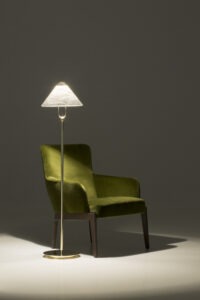
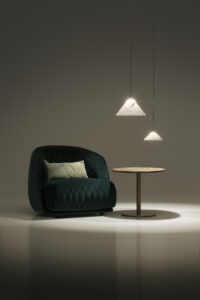
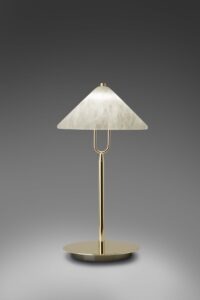
Paros Alabaster collection. This collection, thats most visible feature is its beautiful alabaster shade. It has a fine and polished touch and no two are the same, since each of them is made with a different fragment of the alabaster block. This collection plays with the contrast between simple structures on one side and the heaviness of the stone on the other: the perfect balance between both is the axis of the collection. Paros Alabaster is ideal for elegant and distinguished spaces, whether in a home, in the lounge of a hotel, in sophisticated hospitality spaces and, in general, in avant-garde interiors, although it also adapts to a vintage decorative style.
The collection consists of four models: floor, table, wall and suspension. The structure is made of painted white textured iron and the shade is made with polished alabaster. All versions include a E14 socket, allowing the end user to choose from all the light sources available on the market, specifying the intensity and temperature of light they prefer, either traditional (max.20W) or LED.


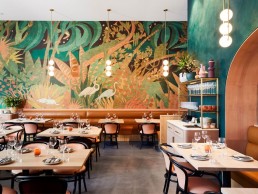
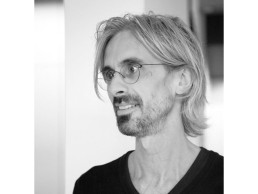

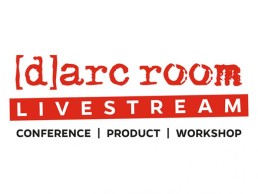
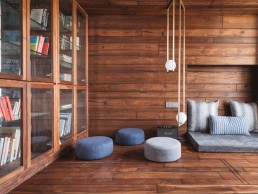
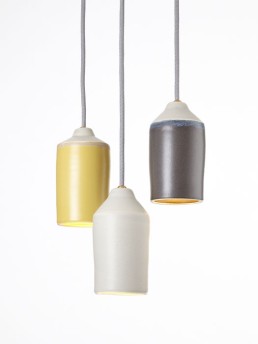
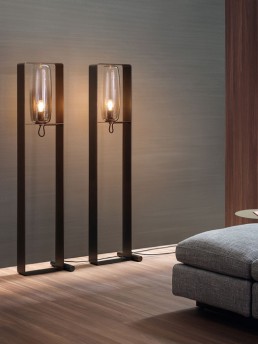
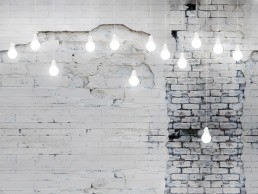
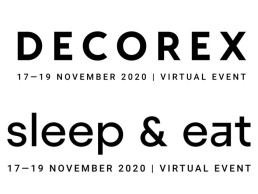
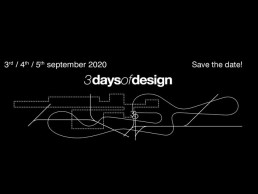
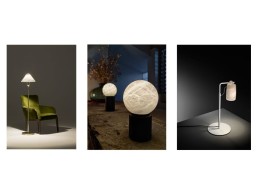
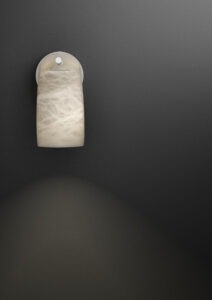
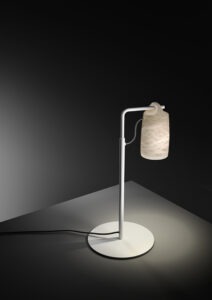
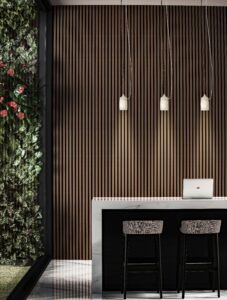

The Future of Design
The world has been turned upside down this year due to the devastating Covid-19 pandemic, which has had global impacts both personally and professionally. with this in mind, darc discusses the impacts on the design industry with leading figures across lighting, interiors and architecture.
It has been six months since the UK went into full lockdown due to the Covid-19 global pandemic. Gone are the days when we complained about the over saturation of Brexit news in the British media, to a time when our headlines are solely dominated by the virus and its impact on modern society.
As we all begin to emerge from its shadow and move into what’s commonly referred to as the “new normal”, we wanted to get an insight from the design industry on how it has been responding to these surreal times we find ourselves in.
We sat down with a group of interior designers, lighting designers and architectural branders to see how their worlds were turned upside down and what they are observing in the design community as it begins to pick itself up again.
We spoke with Helen Ewart of M1NT Studio in Manchester, UK. Beginning her career as an interior designer 15 years ago, Ewart has gained experience in architectural practices both in the UK and Spain, refining her specialism in restaurant design, along with office, bank and residential design. At the beginning of the pandemic, Ewart found herself out of a job due to redundancies at her architectural practice along with her interior design colleagues. “The architect’s practice that we all came from felt the need to reduce the interiors team and therefore made redundancies," she tells darc. "We have seen similarities in other architectural practices, which is hard, however, it has pushed some people to form some fantastic companies or find new roles better suited.” Ewart along with four of her colleagues; Louise Grimes, Janet Steer, Ewa Sydor and Stephanie Taylor made the decision to form M1NT Studio a mere three days after their redundancies and mid-national lockdown.
“Call us stupid but when things this big hit, we need to react," continues Ewart. "We need to fully embrace the change. We may have been made redundant, but our service is certainly not. We need to guide, show and embrace this time and design it for the long-term not the temporary. Everyone is working from home, not only is the need for an ‘instagramable’ home office required but the local high street culture is on the up, businesses started from home in the midst of lockdown are growing and suddenly need a permanent location. Empty retail spaces are being repurposed with work cafés and satellite regional offices, as we can now really work anywhere. The office is far from dead though; it will just be used differently. The need for collaboration still thrives, flexi workspace was already a trend, but it will be less of a ‘nice to have’ and more a necessity. Large offices need to downsize as numbers are halved, and these spaces need clever planning and fresh design solutions.”
Ewart continues, discussing the new working adjustments her and her team made: “As a team we are used to being out of the office, whether we are on-site, meeting clients, surveying, flying to Ireland, training to London; we are used to being ships passing in the night and have become very good at it. So, the aspect has been manageable, using WhatsApp, Zoom, emails – we can’t escape one another even if we tried. However, there are those crossover days in the office that are greatly missed – the office banter, the brew rounds, the tactile aspects of sitting around a meeting table discussing samples – this is invaluable. Managing your own work/home-life balance has its plus sides, accepting a million parcels a day and keeping on top of the clothes washing between emails is handy, but when and if we can get some normality back, I think the balance of flexi-working will be embraced enough to take the stress out of day-to-day life; a couple of office days a week would still be our preference.”
We also spoke with John Williams, Founder of interior design studio Space Invader, also based in Manchester. Talking of his experience of the immediate impact of Covid-19 and his day-to-day work life, Williams says: “It was very challenging at the start on a personal level - juggling family and work commitments from home while navigating a changing and complex business environment, as well as being mindful of the needs of the whole team from a remote perspective. The really important thing to recognise was that everyone in the team had a unique situation in terms of where and how they live, their health, attitudes and anxiety levels. We had to be very flexible to accommodate and work with that. "I think our biggest challenge was the lack of real human contact. We’re very collaborative and it’s so important for us to share knowledge and ideas, which is not that easy to do ad-hoc over Microsoft Teams. We’re back in the studio now on a rotating basis, it’s really good to be back in town, seeing everyone face-to-face again.”
Jo Littlefair of interior design studio Goddard Littlefair has also experienced a very similar situation as Williams, having to make a quick transition to working from home. “As we saw the tsunami of the pandemic approaching, we quickly acted to ensure that all of our studio could work safely from home," she says. "Luckily, we didn’t need huge investments in hardware to enable this, the change in methodology and approach to working was, however, significant.
“We are now all familiar with video calls and whilst they are fantastic, we still miss our team meetings and the sense of comraderie and ease of communication that being together in one space can bring. The huge benefit on our international work is that the need for travel for work meetings has been reduced as people realise that much can be achieved remotely.”
Witnessing an overall positive reaction, from the design industry to the world’s events, Littlefair continues: “Designers are creative beings and we are used to working within constraints to overcome obstacles and inspire change. It’s hard-wired into us, we recognise problems and look for solutions – we’re people pleasers at heart and we want to raise smiles, now even more so.”
When speaking with German-based Lighting Design Consultant Nitika Agrawal, formerly of AECOM, we discovered some of the challenges that came with starting a new business venture during these difficult times: “Before Covid-19 arrived, I had a vision to launch Light Dew and had already started to make fundamental arrangements to support my work remotely. Given the unknown circumstances, I found it challenging to network with people - since all the lighting events were cancelled - or book appointments at my clients’ offices. What I found positive is that I did not have to travel to different countries to attend lighting workshops or conferences, which saved a lot of my time. Due to the internet, the world has become a small place and we can easily connect with each other around the globe and share our knowledge online.”
Elsewhere in the world, we discovered the outcome of the global pandemic to have had similar impacts. Speaking with Italian Architect Sergio Mannino, who is based in New York and specialises in architectural branding in built environments, he comments: “We radically changed the way we worked in a matter of a few weeks, but not everything is remote. We go to the office only when necessary, and everything else is done online. We had already built a communication system a few years ago when working on a large project in Shenzhen, China, so it wasn’t all entirely new to us. I think we transitioned smoothly, but I still miss the human interaction in the office.”
Speaking of the reaction from the design community in the US, Mannino recognised a rapid adaptation to the new situation and a push for innovative design. “I can say we probably pushed innovation to happen much faster than it would have taken in normal circumstances. The downside is that we probably work much more than we used to. We have fewer mental breaks and that’s not positive. When you take the train or walk, you are allowing the brain to rest and process the information you acquired during the day. Being in an enclosed space for so long is not healthy for us and we all need to find a balance.”
Williams adds to this, saying: “There’s been an overwhelming amount of commentary on the future of the workplace, which is a real positive because our clients do need our help navigating through tough decisions ahead.
“From that perspective it’s a positive, though there’s an inevitable slowing down in the workplace market while businesses wait to see what will happen. The design marketplace is a mixed picture, depending on sector, from major downturns in retail, events and experiences to some potential growth in residential rental and UK hospitality. While decisions may be delayed, I’m pretty optimistic that the property industry will react and adapt as it always has done, given time.”
Ewart is also seeing a knock-on effect of the population's mass migration back to their homes. “The world as we know it has completely changed, the extent and size of the shift makes me believe at least some of it will be here to stay and I for one hope so.
“That comes from someone who went into lockdown on maternity leave, was furloughed and into redundancy with four fellow team members. If I can celebrate this change then we can all try?
“Seeing the country blossom in colour from the lack of pollution, acts of kindness from neighbours, family time and re-prioritising our lives are all factors that will impact design and I would love to look at the design forecasts currently brewing. It is like the world is teaching us all a valuable lesson,” she says.
Ewart is also taking note of the design shifts that will become priorities for a lot of upcoming projects: “More specifically, hygienic and wipeable textiles will be worth the money and not just for hospitals and care facilities. We can finally push the ergonomic chairs that were out of the price bracket because people now care about welfare. We can help bring the office space up to date for the directors that presumed flexi workspace and lounge style seating reduced productivity. Café culture finds customers getting settled for a few hours of work and need that socket re-jig and restaurants need to accept that there may not be as many tables but if you are clever with the design you can still attract the masses. We are, in fact, working on a residential job that wants a cinema room; people are re-evaluating what is required in their houses,” she explains.
“More subtly, colours may mirror that of nature and stillness - calm and fresh. Materials could be smooth to appear clean and sterile and biophillia is needed even more as we all embrace that ‘daily exercise.’”
In consideration of future interior design approaches, Littlefair adds: “This will be very interesting to watch. I feel this is an evolution on high-speed. Underlying all of this, I do believe that travel will become highly valued as we’re inexperienced at being so restricted. I feel life experiences and memory making are the new values that people will look for and as such, we need to design to suit those needs.”
Mannino comments: “I believe the change needs to be radical. The entire Modernist architecture was based on building healthy buildings, with as much sunlight as possible, clean surfaces, and so on. The pandemics of the last century pushed cities and architects to design and build in a new way. I think we need to have the same approach, but I am not so optimistic. Everything is driven by capital and not by ideals. There is no long-term plan, developers are only looking for a quick turn around and they are building for that. The pandemic is only a small part of the issue, climate change is a much bigger problem that is completely ignored here in the US.”
In terms of future design and how lighting can be integrated, Agrawal highlights numerous ways in which lighting can be used to aid social distancing regulations: “For large open space offices, it is possible that only a certain number of desks at a distance of six feet will be permitted on each floor. The six feet distance can be measured from the centre of the chair and highlighted using patterns or colours on the floor or reflectors or anti-slip inground lights.
“Many will be encouraged to look into smart lighting by incorporating IoT in their offices, allowing them to gather data and monitor the rate of occupancy, provide circadian rhythm light and disinfect by using UVC light,” she explains.
“People have definitely started to give health and wellbeing greater importance. Greater emphasis is put on ergonomic designs, UX Design, pretty much anything that would enhance the comfort and wellbeing level to the maximum of an individual. I see the pandemic as an evolutionary momentum for the design industry to be creative and provide, with comfort maximising revolutionary solutions.”
Looking at workspace design specifically, Williams’ team has witnessed a shift, as he explains: “There will clearly be some short-term changes here, from one-way systems in the office and rotations of office occupation, as we work towards a more established medium-term ‘social distancing design guide’. These short-term phases, however, will pass when the vaccine (hopefully!) arrives, so I think it’s incredibly important to think of the future in several stages, from the immediate to the medium and longer-term.”
When asked about what practices he’s had to put in place when approaching the new way of working, he added: “We’ve been at the forefront of encouraging collaborative, flexible and agile ways of working for our clients for a long time, so in that sense I wouldn’t say we’ve had to change our work approach radically, apart from enquiring more deeply about the relationship of individuals to the workplace. This is very much a bottom-up not top-down management moment and we need to help clients to recognise this in their own organisations and plan for flexible and organic future growth.
“The big point is that Covid-19 has accelerated the pace of the key, positive changes that were happening anyway – agile working and the accent on health, biophilia and wellbeing. What has been added is an increased accent on hygiene and air quality, both to be welcomed, and a ramped-up attitude to flexibility. We see flexibility as the way by which individuals can be empowered with the choice of carrying out their activities at safe distances and the ability for business teams to grow and contract effortlessly in a space as government guidance and business and personal needs change,” he adds.
“We are seeing organisations more willing to empower individuals to work in the way they choose. This change resonates with us as we have always worked with far-sighted businesses that listen to their people, which involves letting them balance their home and work deadlines to achieve an equilibrium that benefits both them and their employer.
“The major advantages of a physical workspace are for relationship-building and for people to come together for the more collaborative parts of their work, before dispersing either into smaller pockets of space that respect social distancing or else returning to their homes to carry out specific tasks.”
Mannino expands on his predictions for workspace design: “I think there will be a return to the cubicles, compared to the open space model - there are interesting approaches that make it totally flexible and lighting can now be focused on these individual workstations rather than illuminating the entire room evenly.
“I see this as an opportunity to try something different. You can never go back to the old world, the new normal will be something different and people will adapt. I think we will learn something from this, and we will go back to the things we miss the most. In a way it will be a way to evaluate what’s really important and what’s not.”
When asked about what emerging trends might occur in response to the new world, Littlefair says: “Individually, we like a sense of personal space and time and hate being crammed into venues. We also welcome environments that put us at ease while delivering interesting spaces. This speaks to the trend for wellness, which is high on our agendas at the moment. I see people re-evaluating our online lives, we’ve been overwhelmed with emails and video calls for so long, and focussing and balancing the positives and the negatives of what we do digitally and trying to live more in the present and personal time with those people for whom we feel a true connection.
“Ultimately, I think we all have to be kinder to ourselves and one-another. Ironically, Coronavirus combined with the death of George Floyd have given us a lot to reflect on as a global community and I hope that can unite us in a positive response.”
In terms of designing spaces with this flexibility and adding elements that create this atmosphere of wellbeing and comfort, decorative lighting plays a key role. For Littlefair: “Decorative lighting ultimately is much easier to install and manipulate to enable flexibility of social distancing. We’ve seen the festooning of lights using flex and hooks across ceilings in more industrial and urban settings for some time. Pools of light over tables can be used to keep people together around a table and create an intimate atmosphere, great for hotels and restaurants.”
Reiterating this idea of flexible design, Williams adds: “Right now, lighting needs to work harder to adapt to flexible usage of groups or as individual task lights.
“Lighting will play a major role in helping designate areas and identify occupation and usage. It also plays an important part in our wellbeing and circadian rhythms,” he explains.
“In addition, presence sensors in lighting that measure occupancy around the workplace are proving a really useful tool in social distancing.”
Ewart elaborates: “Working from home means everyone has become used to the adaptable, personal, soft home lighting and it will be hard not to feel the effects and strain as they work under the bright consistent tones [in an office]. If management want to persuade staff to re-enter the 9-5 office world after so long doing it solo, they need to strongly consider lighting design. Task lighting, diverse and adjustable will be key.”
Looking to the future and the evolution of design in response, Littlefair concludes: “There will be a lot of changes, we’ve all been forced through some extreme conditions that will have reverberations. It’s shown many of us that the future is not as predictable as we thought it was. However, people also love being with other people, there’s no substitution for a real conversation and we’ve all recognised the value of personal relationships. Creativity feeds from a team of people working together for the greater good, so there is a real vitality in that process, and we need to create environments which foster that.”
www.goddardlittlefair.com
light-dew.com
m1ntstudio.com
www.sergiomannino.com
www.spaceinvaderdesign.co.uk
by Sarah Cullen